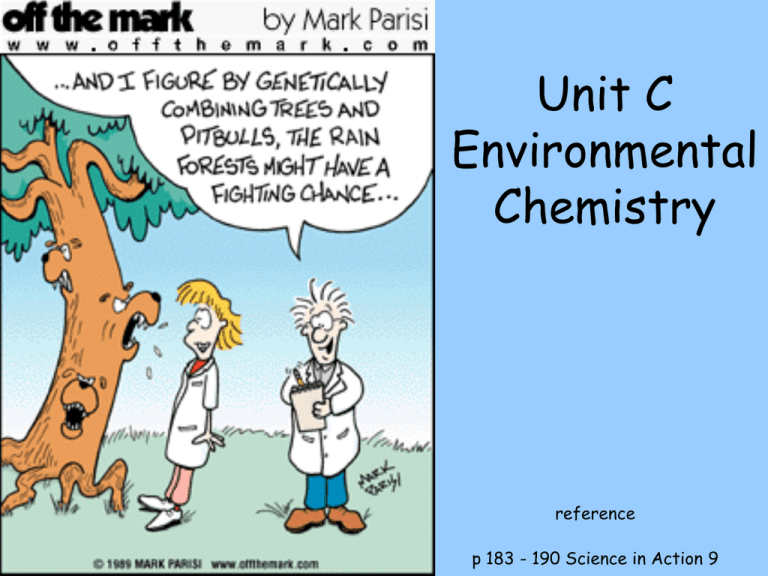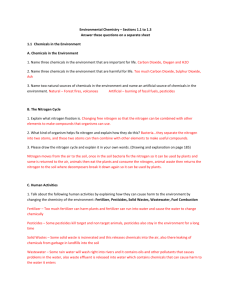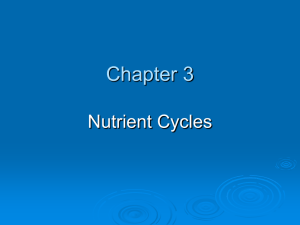Unit C - Topic 1.0 Notes
advertisement

Unit C Environmental Chemistry reference p 183 - 190 Science in Action 9 What is Environmental Chemistry • Environmental Chemistry Summary • Should you trust Chemists or Cows? UNIT C ENVIRONMENTAL CHEMISTRY Section 1.1 Chemicals in the Environment • All living things are made of chemicals and depend upon chemistry for survival. • Some chemicals that are produced either naturally or by humans can be harmful to the living and non-living environment. • Elements such as carbon and oxygen are constantly moving throughout the ecosystem in a cyclic pattern as they form chemical compounds that are used by living things. • Water is a compound that cycles through the environment. The Nitrogen Cycle • Nitrogen is an important element since it is required by plants to make substances necessary to life. The concentration of useable nitrogen can be added or taken away from the soil in several ways: • Nitrated are added by: 1. nitrogen fixing plants 2.fertilizers/compost/manure 3. lightning • Nitrates are taken away by: 1. bacteria that convert soil nitrates into free N2 2. water carries away nitrates 3. harvesting plants More on nitrogen fixation • Nitrogen fixing plants like legumes (clover, alfalfa, beans) contain bacteria in their root nodules • These bacteria convert free nitrogen (N2) in the air into nitrates that can be used by plants, so they fertilize the soil! • Nitrogen and Phosphorus cycles Processes and Activities that Affect Environmental Chemicals A. Natural Processes: • Chemical Cycles – cycling of elements and compounds through the environment, like the nitrogen cycle • Cellular respiration – food chemicals and oxygen are used to provide the body with energy, carbon dioxide is produced B. Human Activities: 1. Pollution – any change in the environment that produces conditions harmful to living things, such as smog and forest fires There are many kinds of pollution • Noise • Thermal (Lake Wabamun) • Chemical 2. Agricultural Activities – farmers use chemicals to help control the growth of their crops. a) Fertilizers - chemicals added to the soil to increase plant growth. - usually contain nitrogen, phosphorus and potassium, three elements essential for plant growth. Sometimes sulfur is added. 10 % K Fertilizers are labeled with a number that indicates the percentage of nitrogen, phosphorus and potassium Different ratios are used to achieve different goals Eg. Root growth, or leaf growth problem: too much can harm the crop b) Crop rotation Crops that are nitrogen fixing increase soil nitrates eg. clover, alfalfa and peas c) Pesticides - chemicals used to kill pests (organisms that harm people, crops or structures). - grouped by what they kill: herbicides kill weeds, insecticides kill insects, fungicides kill fungus Problems: 1. some are not selective and kill both pests and non-pests (Round-up) 2. some remain in the environment and can be passed on to other organisms 3. pests can become resistant to them Organic Foods- are grown in an environment free of pesticides PESKY PESTICIDES • an estimated 20,000 cancer deaths each year in the U.S. are caused by pesticide residues on food • an estimated 3.5 million cases of acute pesticide poisoning are caused each year in developing nations due to lack of protection during pesticide application • an estimated 900 plant and insect species have built up resistances to pesticides • 4.1 billion pounds of pesticides are used throughout the world each year • 30 times more pesticides are used today than were used in 1945 • 30 percent of insecticides are believed to be carcinogenic • 60 percent of herbicides are believed to cause cancer • 90 percent of fungicides are believed to be carcinogenic (cause cancer ) • 23 of the 28 most commonly used pesticides are believed to be carcinogenic 3. Solid Wastes – garbage from homes and industry that cannot be recycled is put into landfills which are specially constructed with plastic liners and compacted clay to prevent chemicals leaking into the ground (leaching). Some solid waste is incinerated or burned at high temperatures and some of the gases released contribute to air pollution. 4. Wastewater or Sewage – water containing dissolved and undissolved materials, called sewage, is carried by pipes into a septic tank in rural areas and to water treatment plants in the city. Septic tank – underground container where bacteria break down organic materials before they are moved out into the soil Sewage treatment plant – treats wastewater from homes and industry and releases it (now called effluent) into rivers and lakes. Effluent often contains nitrogen and phosphorus. Storm sewers – large areas used to collect street water before it is released into rivers and lakes. This water contains chemicals washed off the street. Waste Water Sewage (all waste water from your home) enters here! 5. Fuel combustion – oxygen is used to burn fossil fuels and energy, H2O (g), CO2 (g), are released. Fossil fuels –fuels formed from dead plants and animals, such as coal, oil and natural gas. - these are also called hydrocarbons since they are made up of hydrogen and carbon though they may contain oxygen, nitrogen and sulfur - when burned, these fuels often release pollutants such as sulfur dioxide, nitrogen oxides and traces of mercury and lead 6. Industrial Processes – including electrical power generation, mineral processing and fertilizer production • Natural gas – natural gas is composed of various compounds that can be separated and used. Methane, propane and butane are used for heating and ethane is used to make plastics. • An unwanted substance is the poisonous chemical hydrogen sulfide. If gas contains this chemical, it is called “sour”. To remove it, sulfur and sulfur dioxide are made. Since sulfur dioxide is a pollutant, there are restrictions on the amount released. • The sulfur is recovered and used to make fertilizers, paints and steel. What can YOU DO? • Use phosphate free laundry detergent • biological controls instead of pesticides • walk or ride your bike instead of consuming fossil fuels and creating pollution • reduce your solid wastes • P 181 Quicklab • Do questions 1-11 on page 190 Topic 1.2 ACIDS AND BASES The pH Scale • pH is a measure of the concentration of hydrogen ions in solution 0 1 2 3 4 5 6 7 8 9 10 11 12 13 14 Most Acidic 7= neutral Most Basic • pH is a base 10 logarithmic scale. • Every increment is a power of 10. • A pH of 5 is 10 times more acidic than a pH of 6 and 100 times more acidic than a pH of 7! • A pH of 12 is 10 times more basic than a pH of 11. ACIDS taste sour soluble in water corrosive conduct electricity react with metals most formulas begin with H (hydrogen) Examples: HCl - hydrochloric acid H SO - sulfuric acid - acids you would find at home include acetic acid (vinegar) and citric acid (found in fruits) 2 4 • Acid – a compound that dissolves in water to form a solution with a pH lower than 7 - acid rain is produced when chemical released from industrial processes combine with water to form acids that fall with the rain, SO2 + H2O H2SO3 sulfurous acid, Nox + H2O HNO2 and HNO3 nitrous and nitric acid, CO2 carbonic acid Acid Rain • When gases in the atmosphere combine with water to form rain that is more acid than normal. • Kills and deforms living organisms, causes amphibian eggs not to hatch, increases rate of rust formation, chemical degradation of limestone statues and buildings. • Coal Combustion Acid Rain • BBC Acid Rain • Buffers - The slayes of Acid Rain • Taste bitter • soluble in water • feel slippery • corrosive • conduct electricity • react with acids • found in soaps, detergents • end in OH (Hydroxide ) Eg. NaOH - sodium hydroxide, fish oils • Base – a compound that dissolves in water to form a solution with a pH higher than 7 - many household cleaners are basic, from Draino to shampoo and soaps • Neutral – a pH of 7, it is neither acidic nor basic e.g. Distilled Water Acids can be neutralized by adding a base (liming), and bases can be neutralized by adding an acid. Neutralization – a reaction where an acid and base come together to produce water and a salt. This reaction can be used to neutralize stomach acid or basic chemical spills, and can help combat the effects of acid rain. • In some parts of Canada, rain can have a pH as low as 3. Acid rain can have devastating effects on the biotic and abiotic parts of the ecosystem. • One way to decrease its effect is to neutralize lakes by adding lime (calcium hydroxide), producing water with a neutral pH. Neutralization Reaction • A reaction between an acid and a base where water (HOH) and salt are formed • E.g. HCl + NaOH hydrochloric acid + Sodium Hydroxide HOH + NaCl water + sodium chloride (salt) Buffers • A buffer is a substance that can neutralize either an acid or a base • An example of some bases which can buffer acids are antacids : eno, tums, pepto bismol. • Baking soda is basic and can also buffer an acid. Measuring pH 1. pH meter – the probe is dipped into a solution and the meter indicates the solution’s pH 2. pH indicators – substances which change in color to indicate pH ie. litmus paper– blue litmus turns red in acid, red litmus turns blue in base - pH paper is more accurate • a universal indicator – shows a wide variety of colors, each indicating a different pH when compared to a color chart (They are a different color in an acid than in a base) • There are many other natural indicators e.g. red cabbage • Lab: measuring acids and bases • Bromothymol Blue: – With acid-yellow – With base- blue – In neutral-green • Lab: Neutralizing Acids p.194 • 5 Human Impacts on the Environment Unit C Section 1.3 Common Substances Essential to Living Things • Of the 25 elements are needed for growth of living things, carbon, oxygen and hydrogen are the most common. • They make up molecules of carbohydrates, lipids, proteins and nucleic acids. • molecules that contain carbon are organic • those without carbon are called inorganic Nutrients • elements and compounds needed for living, growing and reproducing Macronutrients • 9 elements that are needed in large amounts. • C, H, O, N, P, K, Mg, Ca, S. Micronutrients • elements needed only in trace amounts • Eg. Fe, Se Nutrient Importance in Plants Importance in Humans Nitrogen (N) - proteins & chlorophyll - leaf and stem growth - composition of proteins & nucleic acids - growth and repair of tissue Phosphorus (P) - root and flower growth - cellular respiration & photosynthesis - composition of bones, teeth & DNA - metabolic reactions Potassium (K) - stimulates early growth - starch and protein production - disease resistance - chlorophyll production & tuber formation - muscle contraction & nerve impulses Magnesium (Mg) - chlorophyll structure - photosynthesis - composition of bones & teeth - absorption of calcium & potassium Calcium (Ca) - cell wall structure - cell division - composition of bones & teeth - blood clotting - muscle & nerve function Sulfur (S) - production of fruits and grains - protein synthesis - enzyme activation - detoxification Optimum Amounts • too much or too little of a nutrient can be harmful to an organism. • eg. Selenium is an element required in trace amounts in our diet – too little is linked to cancer and heart disease, too much can lead to death. Types of Organic Molecules 1. Carbohydrates • made up of C, H and O. • Foods like pasta, rice and potatoes are rich in complex carbohydrates. • There are two categories of carbohydrates: Simple Sugars: -one or two subunits long -glucose is a simple sugar made by photosynthesis Complex Carbohydrates: - long repeating chains of glucose joined together - eg. starch, cellulose and glycogen. • Starch: used for energy storage in plants • Glycogen: used for energy storage in animals • Cellulose (fibre): found in plant cell walls 2. Lipids • made up of many C, H and O atoms. • fats, oils or waxes • produced by both plants and animals. 3. Proteins – C, H, O, N • meats, fish, eggs and dairy all contain protein. • used for growth and repair and as a source of energy. • Enzymes are specialized proteins that control the rate of chemical reactions in the body. • Proteins are made up of repeating units of amino acids • There are 20 different kinds of amino acids. • Each protein has its own number and arrangement of amino acids • Proteins are long chains of amino acids 4. Nucleic Acids – C, H, O, N, P • largest and most complex molecules in living things. • play a major role in heredity and controlling cell activities. • Two nucleic acids are DNA (deoxyribonucleic acid) and RNA (ribonucleic acid) • They are made of a phosphate, a simple sugar, and a nitrogenous base. Unit C Section 1.4 How Organisms Take in Substances Nutrients Animals • Consumers rely on organic compounds made by plants for their energy, growth and repair. Plants • Plants rely on inorganic compounds which they turn into organic compounds. PLANTS 1.Passive Transportation • movement of molecules that does not require an input of energy a) Diffusion – the natural movement of molecules from an area of high concentration to an area of low concentration. Nutrients move into plant roots this way until the concentration on the outside is equal to the concentration on the inside. • Diffusion Animation b) Osmosis – the movement of water molecules across a membrane due to a concentration gradient (from high to low concentration). Water moves into plant roots this way. • osmosis vs diffusion osmosis demo with an egg 2. Active Transport • energy is used to move molecules against the concentration gradient, from low to high concentration. • Roots of plants take up some nutrients this way. active and passive transport ANIMALS 1. Ingestion • taking food into the body. Animals ingest, then breakdown the food particles for absorption. 2. Mechanical breakdown • the physical breakdown of food by chewing. 3. Chemical breakdown • enzymes breakdown food into its smallest particles through a process called hydrolysis. • This happens in the mouth, stomach and intestine. Hydrolysis • the addition of water breaks down large food particles into its smallest form. These molecules have been hydrolyzed. • Nutrients are transported through the body by the bloodstream. NUTRIENT UPTAKE IN DIFFERENT ENVIRONMENTS • Where an organism lives affects how it takes up nutrients. • Substrate – the material on which an organism lives. Some organisms simply attach themselves to the substrate, but others actually feed off their substrate. Assignment: • Page 209 # 1 to 7 • and page 211 # 1 to 9









